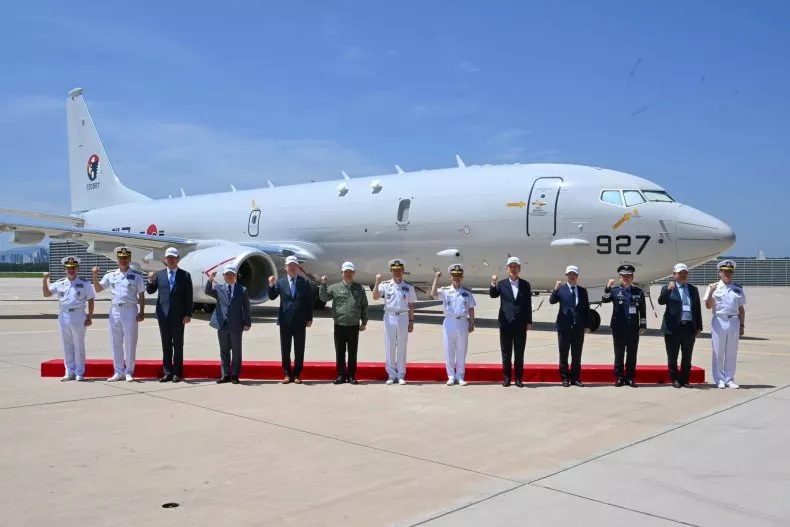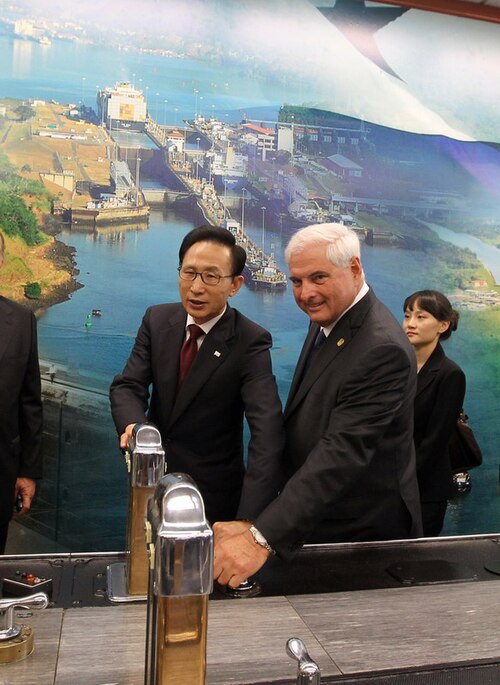South Korea a Significant User of the Panama Canal, Flies New Submarine Hunters To Counter North Korea’s Navy
South Korea’s navy holding a ceremony to take over a P-8A Poseidon maritime patrol aircraft at the Naval Air Command in Pohang, South Korea.

Panama and South Korea have maintained diplomatic relations since 1962, with both countries establishing embassies in each other’s capitals. Bilateral ties have strengthened over the years, including through high-level exchanges and trade agreements.
Key Aspects of Panama-South Korea Relations:
- Diplomatic Relations:
Established in 1962, with embassies in Seoul and Panama City.
- High-Level Exchanges:
Leaders from both countries have engaged in regular visits and meetings to foster cooperation.
- Trade and Economic Cooperation:
South Korea is a significant user of the Panama Canal, and both countries are working to expand trade and investment.
- Free Trade Agreement (FTA):
South Korea has signed an FTA with Panama and several Central American countries, which is awaiting full ratification by Panama.
- Cultural and Social Ties:
The Panama-Korea Association was established to promote connections in various areas, including commerce, academics, and culture.
- South Korean Presence in Panama:
South Korea has a consulate in Panama City with two technical offices (SEGUMAR-SEOUL & SEGUMAR-BUSAN) to support its maritime interests, according to the Panama Maritime Authority.

In June 2010, South Korean President Lee Myung-bak above left visited Panama. Later, in October, he received his Panamanian counterpart Ricardo Martinelli above right at Cheong Wa Dae for summit talks.
In 2021, Panama’s exports to South Korea amounted to $380 million. South Korea is the third largest export partner of Panama.
US Submarine Hunters VS North Korea’s Navy
South Korea began flying its fleet of P-8A maritime patrol aircraft—acquired from its ally the United States—to counter North Korea’s navy, including its destroyers and submarines. The P-8A is capable of conducting anti-submarine and anti-surface warfare missions. South Korea received all six maritime patrol aircraft from Boeing in June 2024.
Why It Matters
South Korea, known officially as the Republic of Korea (ROK), hosts about 28,500 U.S. military personnel to deter provocations and attacks from nuclear-armed North Korea as both sides technically remain in a state of war following the conclusion of an armistice—but not a peace treaty—after the Korean War. In addition to developing its nuclear forces, North Korea—under the leadership of Kim Jong Un, pictured below—has been modernizing its conventional military power, including launching two 5,000-ton destroyers and a missile-armed submarine, as it seeks to establish a “world level” navy.

What To Know
Citing military officials, Yonhap News Agency of South Korea reported that the country’s P-8A maritime patrol aircraft—operated by the navy—began deployment last Thursday following the completion of preparations, including flight exercises and personnel training. The aircraft, also known as Poseidon, is tasked with detecting North Korean submarine fleet, according to South Korean military officials, as it is capable of being armed with sonobuoys and torpedoes, which are designed to detect, identify, track and attack underwater targets. Boeing, which manufactures the aircraft, said an upgrade was being installed on the Poseidon operated by the U.S. Navy, enabling it to counter the world’s most advanced submarines.
It remains unclear whether the upgrade will also be applied to South Korea’s Poseidon fleet. The Poseidon is also capable of carrying missiles for anti-ship missions. According to the South Korean navy’s news release, the Boeing-made aircraft is equipped with long-range radar, high-resolution imaging and detection equipment, and electronic warfare systems. The P-8A fleet is scheduled to replace the South Korean navy’s aging P-3C patrol aircraft, which flies slower and has a shorter range. In late May, one of the P-3C aircraft crashed in the southeastern city of Pohang during a training flight, killing all four crew members. Australia, India and New Zealand are three Indo-Pacific countries that also operate the Poseidon, according to Boeing.
What People Are Saying
South Korea’s navy said in a news release in June 2024: “The procurement of the P-8A will significantly strengthen the ROK Navy’s aerial anti-submarine warfare capabilities against North Korean submarines, improve rapid response capabilities in future maritime operations, and expand surveillance capabilities over our waters.” Boeing said on its website: “The P-8 Poseidon offers the size, weight, power and cooling capacity to support evolving mission needs, including the integration of additional mission systems to enhance operational versatility. The P-8’s open mission systems architecture means rapid, affordable technology insertion for decades of mission readiness.”
What Happens Next
It remains to be seen whether South Korea will make an additional purchase of the P-8A aircraft as North Korea continues to expand its navy.






